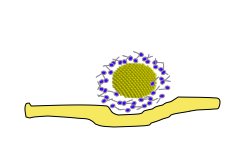There is an ovarian cancer drug called DOXIL that is delivered to cells in a nanoparticle made of molecules of fat. But, how does the nanoparticle enter the cell?
According to a recent study that uses computers to model this process, there are mainly 3 ways in which scientists think a nanoparticle can enter the cell: penetration, endocytosis, and semi-endocytosis.
In order to enter a cell, the nanoparticle has to cross the cell membrane, which separates the internal components of the cell from the outside.
Endocytosis and Semi-Endocytosis
Endocytosis occurs when the membrane starts wrapping up the nanoparticle slowly until it is fully inside. This often occurs with the help of different components on the outside of the cell membrane, known as receptors. When this happens, the nanoparticle becomes wrapped in a coating of the cell membrane, and this wrapped particle is known as a “vesicle.” In the case of semi-endocytosis, the nanoparticle is also wrapped up slowly but it is never fully inside—a part of it will stay on the surface.
Penetration
When a particle is sufficiently small, scientists believe it can simply slip through the cell membrane in a process known as penetration. We are actively investigating the molecular-level details of how this process might occur, as much of it is still a mystery. This process is distinct from endocytosis in that penetration does not form a nice wrapped-up particle in a vesicle.
Adhesion
When a particle begins the process of entering a cell but does not continue, it is known as adhesion. Adhesion is pretty much a fancy word for nanoparticles sticking to the membrane. During adhesion, this study predicts that the cell membrane bends a bit, but does not continue to bend and allow the nanoparticle to be wrapped up as in the case of endocytosis. This happens because energetically it is not favorable for the membrane to go beyond bending. Some factors contributing to this may be poor electrostatic interaction, or interactions of neighboring nanoparticles.
There have been a few publications that describe the mechanism of entry of different nanoparticles into the cell. In these studies they describe which receptors, if any, are responsible for semi- or regular endocytosis, etc.
All the pathways discussed here have been studied through computational simulations. We in the Center are actively investigating experimentally what happens when nanoparticles interact with cell membrane components. There is a lot of work left to be done to decisively conclude that these are indeed the three main ways nanoparticles enter cells and to discover exactly how they occur.
Part of my summer project with the Center for Sustainable Nanotechnology’s Research Experiences for Undergraduates program is to track these nanoparticle/membrane interactions using a variety of different scientific techniques. I hope I can contribute to answering these questions.




[…] Para leer el blog original en inglés, presione aquí. […]
Nice intro to the issue of nanoparticles entry & interactions with cells. Two notes however:
1) I had never heard of “semi-endocytosis” before so I did a little search. Pubmed gives zero result. Using other search tools, I could only find one peer reviewed article using this term; a computer simulation Soft Matter article (DOI: 10.1039/c3sm50931a). This suggests that this concept has little (if any) biological relevance.
2) I have heard many times of particles magically penetrating through membranes (and there are a very significant number of peer reviewed papers making such claims), but I think that it is very unlikely and that the current level of evidence is far from convincing. I discuss this in some details in this blog post & storify. There is also a relevant section in this ACS Nano review (open access).
Hi Raphael,
Thank you so much for your insights into this issue!! Regarding semi-endocytosis I certainly agree that the concept is pretty ill-defined and it seems likely to not be relevant. We linked to our source for this pathway in the very beginning of this post, and tried to make it as clear as possible that we based the content of this post on that article. Thanks for the additional reference & thoughts about the irrelevance of this pathway. We certainly didn’t mean to imply that the particle invoked magic of any kind in the penetration pathway. Excellent blog post on the subject! Thanks for the links!
Lee